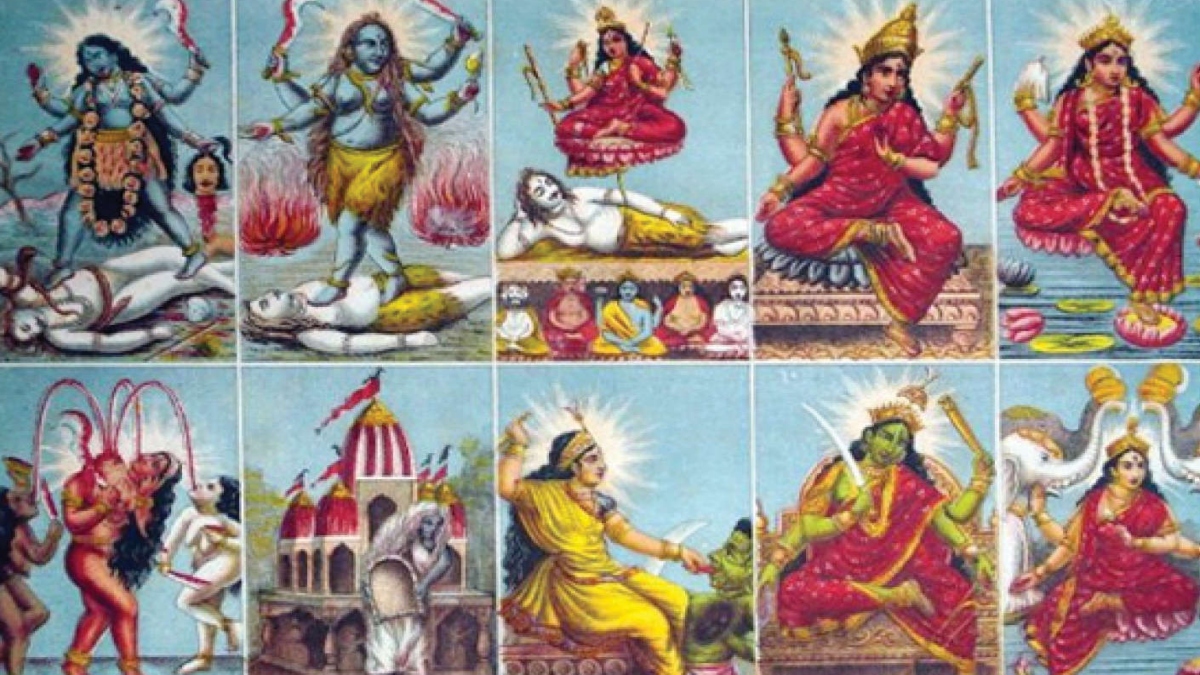
Once, during a game of dice between Shiva and Parvati, Shiva lost, and Parvati asked for the crescent moon adorning his hair as payment. When he refused, she got angry. This in turn infuriated Shiva, who threatened to leave. No amount of cajoling by Parvati helped. Eventually, to block Shiva’s way, Parvati transformed herself into various forms, blocking all ten directions.
These are the Dasha Mahavidyas or Ten Wisdom Goddesses in Hindu mythology, covering the whole range of feminine divinity, from horrific goddesses to beautiful Devis. Each Goddess has her own cosmic function in universal harmony, and meditating upon her leads to realisation of the mysterious nature of the self.
Kali, the first Goddess symbolises time, death, and destruction. When one starts on the spiritual path, one will first have to transcend the fear of time and death and recognise the temporary nature of the world. The second Goddess Tara represents invoking the compassion of awakened masters to show us the right path.
One now seeks a wise and gentle Guru who will strengthen one in times of need and distress. The third is Shodashi, the sixteen-year-old. This reminds the seeker of the youthful exuberance and lightness of true knowledge, which is seen here as the realisation of the splendour of nature, the profound harmony, and principle in all things. The fourth, Bhuvaneswari represents the vastness of space. She implies an increase in one’s consciousness that appears by pursuing true knowledge. The seeker now realises that momentary realisations during meditation are of no consequence. Bhairavi, the fifth Goddess implies diligent spiritual practice, whereby the adept attains great focus and perseverance to succeed. With the arising of true knowledge, the ego is annihilated and the seeker acquires immense courage- seeing beyond duality. The sixth, Chinnamasta, represents this as the Goddess who cuts off her own head.
But here comes a great hazard.
The seeker is now suddenly attacked by a phase of emptiness, deep sorrow, and doubt. It has sometimes been called ‘The dark night of the Soul’. One is racked with doubt and wants to discard all practice- feeling that all that one has done so far is futile. Many seekers have become so depressed in this phase that they have even tried to commit suicide.
Their faith in their God, their practice, and their master is completely shaken. The seventh Goddess, Dhumavati, symbolises the power of this void. Perseverance and immense inner strength are needed to transcend this phase and to recognise the transience of even one’s faith and beliefs. On the passing of this great darkness, one experiences the dawn of true awakening. One is stunned into complete silence- not knowing how to relate to this new reality- since there is no ‘other’, thus no relating at all. One remains transfixed, hypnotised into silence. In such a state, the realised one moves through the world as if in a trance. It’s said that Gautama Buddha remained in such a state for several days after he awakened.
The eighth Goddess is Bagalamukhi, the Goddess who seizes the tongue. Once awakening occurs, nothing remains sacred or profane. All appear to be the same reality. One sees beauty in everything.
There is no duality-no right or wrong, good or bad. Often, the awakened one forgets to remain “clean and washed”. Often, such people lose body consciousness, whether they are naked or clothed. Matangi, the ninth Goddess, represents this phase, as’ one who is unmindful of pollution. Eventually, the self-realised soul begins to “play” in the world. The awakened ones playfully follow worldly customs and yet experience no bondage. Around such people, people experience joy, the vanishing of sorrows, abundance, natural creativity, and spontaneous solutions to their material problems. Miracles and occult powers are said to remain vassals to such realised souls- who have no use for them.
Kamala, the tenth Wisdom Goddess, implies abundance and spiritual perfection. Kamala represents the full unfolding of the power of self-realisation in the material sphere. Meditations on the Goddesses are forms of self-inquiry, representing the secret and subtle. Their forms are often disturbing; not just meant for idle ‘idol’ worship, but also to shock one into higher awareness. Unless one is willing to look beyond the apparent, it’s easy to remain entangled in the outer forms of the Goddesses. The Dasha Mahavidyas reveal the inner workings of both the cosmos and one’s psyche. They represent the deeper truths of life—beyond attachment to name and form.
Deepam Chatterjee teaches meditation and lectures on mysticism and mythology.
The ten Mahavidyas, or Wisdom Goddesses, represent distinct aspects of divinity intent on guiding the spiritual seeker toward liberation. Each Goddess has her own cosmic function in universal harmony, and meditating upon her leads to realisation of the mysterious nature of the self. The Dasha Mahavidyas reveal the inner workings of both the cosmos and one’s psyche. They represent the deeper truths of life beyond attachment to name and form.















